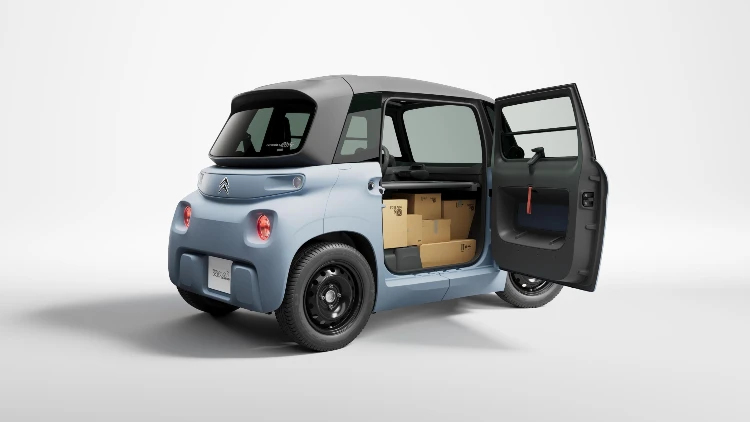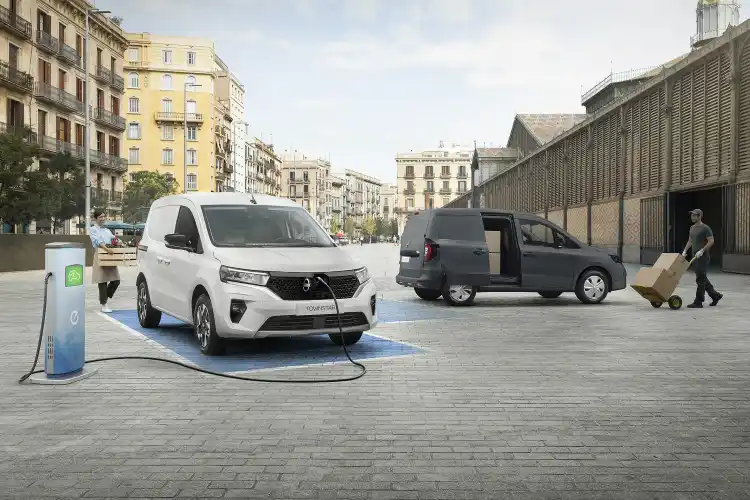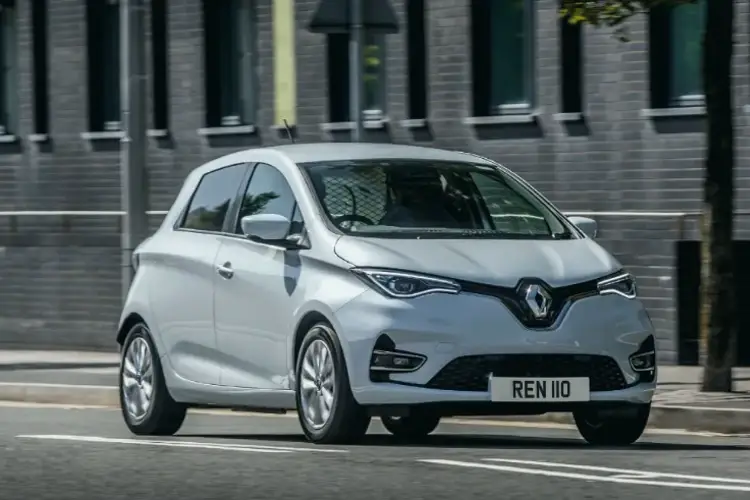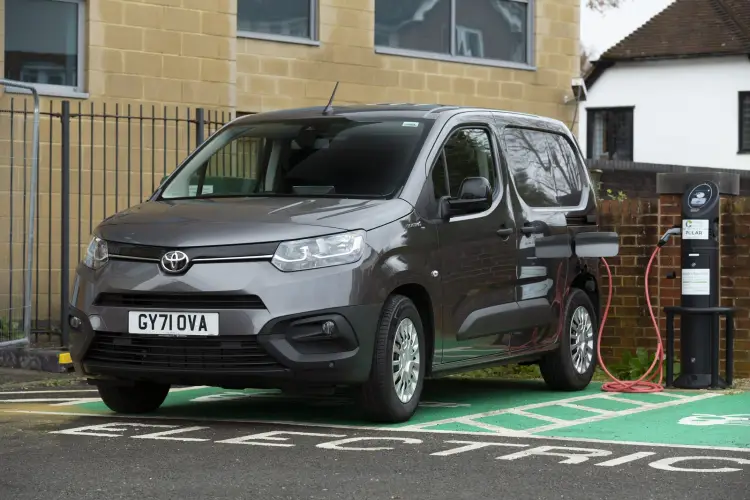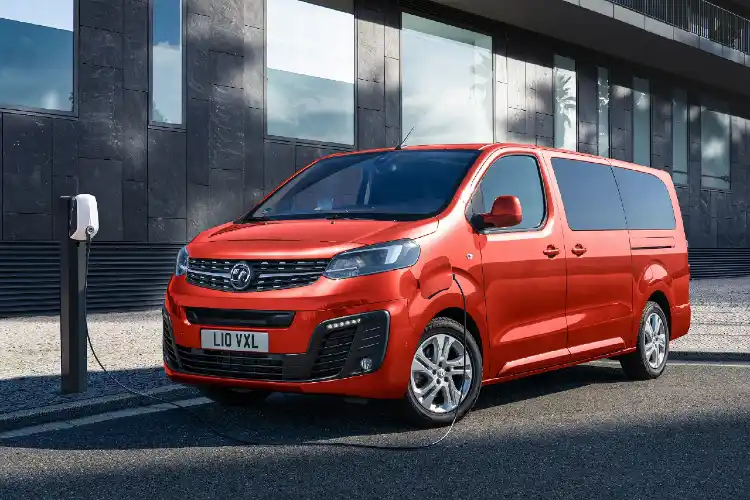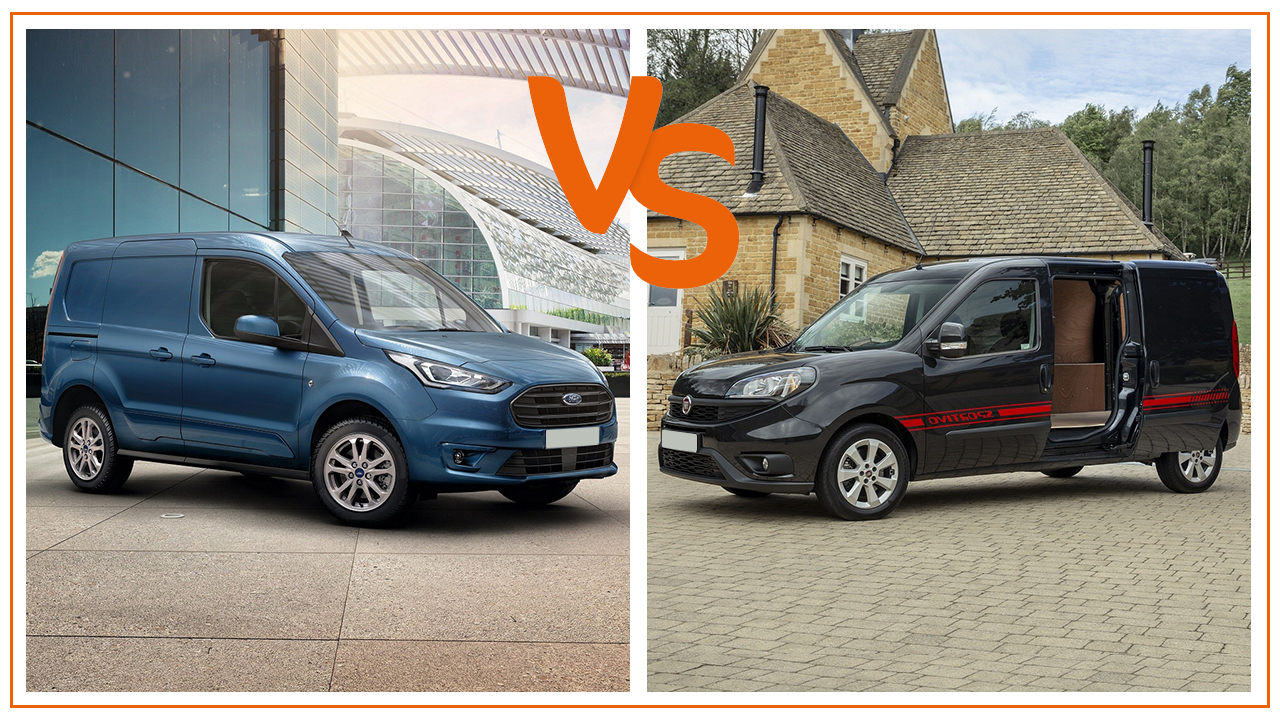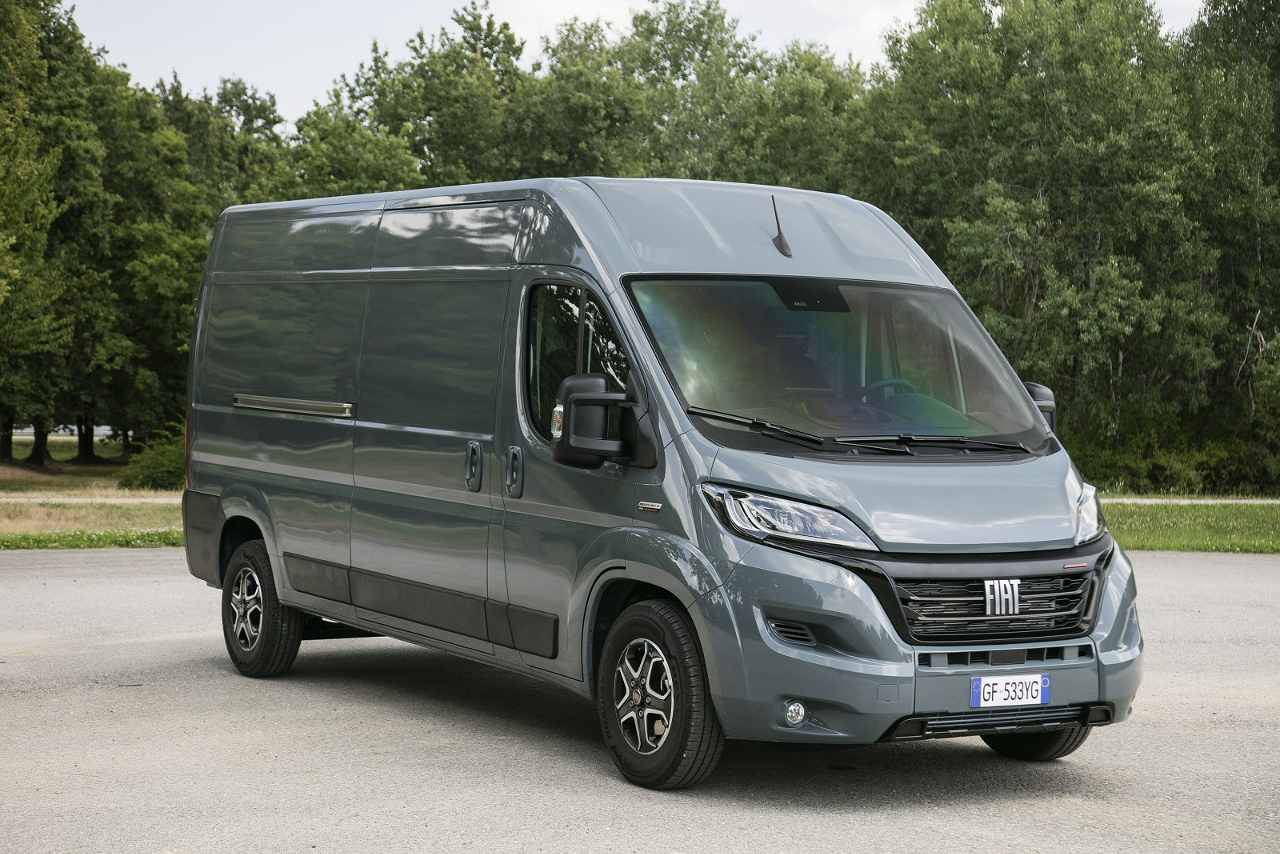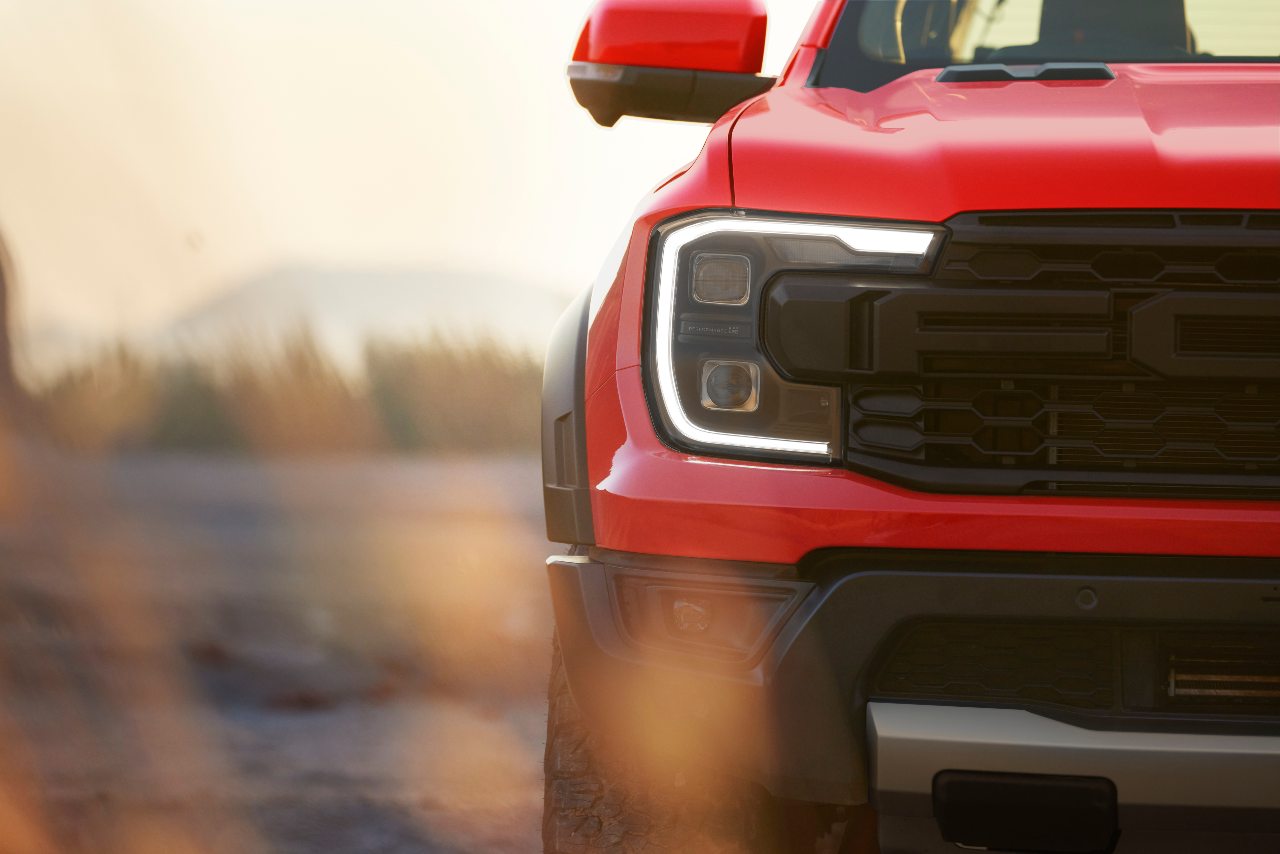By Tom Roberts
The electric van market is evolving rapidly and it can be hard to keep pace with who’s doing what, which is why Vanarama Van Expert Tom Roberts has decided to summarise the electric vans on offer (now and in the future) from each manufacturer.
To be absolutely fair to each manufacturer, I’ll put these in alphabetical order. I’m just going to look at fully-electric vans (not hybrids) and as a general note, all ranges mentioned are the official WLTP combined cycle figures quoted by the manufacturer. Great for comparison purposes, but don’t rely on them for real-world accuracy, it’s unlikely you’ll get close to the numbers, road and driving conditions together with payloads being carried will all play their part in bringing that range down (but often not by much).
Arrival
You might not have heard of Arrival, but this is no tiny start-up business, it’s based in the UK and USA and has a headcount of over 1700 people. The van was announced some time ago, which has given people a chance to get used to its slightly unorthodox looks, but underneath the futuristic exterior this is a serious electric van.
It’s not (yet) in full production, but the manufacturer hopes to commence building the van in late 2022. Unlike some electric vans there’s a full range of body sizes, the Arrival being offered in 4 lengths and 3 roof heights. Payloads will be up to 1975kgs thanks to the van’s 4250kg GVM (Gross Vehicle Mass), Arrival wisely taking advantage of the government's licensing dispensation for EVs over 3500kg.
The 120kW (163hp) electric motor drives the front wheels and is provided with electricity by one of 4 available battery packs. Opt for the largest 139kWh version, and you’ll get an official range of 211 miles. Even the smallest 67kWh version offers 112 miles - which will work for some, not for all.
Citroen (& Stellantis In General)
As these vans are almost identical to those offered by fellow Stellantis brands - Fiat, Peugeot and Vauxhall (and Toyota), I’ll go into detail here using the Citroen vans as examples, and refer back when we get to their siblings bearing different badges.
e-Berlingo: The Berlingo was always going to be a prime candidate for electrification. This (not so) little van has been a favourite of small businesses for decades, taking decent payloads, and with a reputation for reliability and economical engines. The challenge for Citroen was to make sure that the core values of the van were retained, helping their customers make a seamless transition to the world of electric vans.
A payload of up to 800kgs instantly marks this van out as a capable workhorse but the e-Berlingo doesn’t stop there. Being capable of covering 171 miles on a single charge placed this van in joint 5th position in our recent look at electric vans with the best ranges. The 136PS electric motor makes the van pretty nippy with a top speed of 84mph, and you’ll get an 80% charge from a rapid DC charger in just 30 minutes.
e-Dispatch: Citroen’s offering in the medium van sector is the Dispatch. While not as big a seller as its smaller sibling, the van in diesel form has some excellent specifications and features, many of which have been carried over to the all electric e-Dispatch.
Once again, the key selling points are payload and range, and Citroen has absolutely nailed them both. Need to carry some serious weight? How does up to 1226kgs grab you (model dependant)? That’s a highly-competitive payload for a medium van in diesel guise, let alone a van that has a heavy battery pack on board!
This van gained second place in our survey of electric vans with the best ranges – a whopping 196 miles from a fully-charged van fitted with the larger of the 2 battery pack options. More than enough to keep the vast majority of van users going for a full working day, or even a week in some cases.
Also being supplied with a 136PS motor, the e-Dispatch should be nippy enough for most, and a choice of 3 lengths offering up to 6.1 cubic metres of loadspace together with 2 trim level options means that there’s bound to be an e-Dispatch for all.
e-Relay: Finally from Citroen, there’s the e-Relay. The Relay van has never troubled the biggest sellers in the large van sector, but if you asked anyone familiar with what the van was known for, you’d probably get comments such as ‘no nonsense’, ‘no frills’ and ‘good payload’ in response.
If I’m honest, Citroen hasn’t really committed to the electrification of Relay as it has with the smaller vans in its range. Rather than an in-house product, they’ve subcontracted the task to a UK company and the resulting product isn’t really overwhelming.
There’s a choice of 2 battery packs – the only advantage of specifying the small, 37kWh option is the resulting payload of around 1070kgs in the L2 length vehicle which in itself isn’t great for a large van. The disadvantage is a range of just 73 miles, compared to 154 miles with the alternative battery, which has twice the capacity at 75kWh but knocks payload back to a meagre 690kgs depending on model.
On the plus side, you can order an e-Relay in 3 different load lengths, not something that all manufacturers allow, often reducing the number of body options drastically in comparison to the diesel equivalents. Also, to their credit, the French manufacturer has taken advantage of the dispensation allowing alternatively-fuelled vans of up to 4250kg GVM (Gross Vehicle Mass) to be operated and driven under the legislation that normally applies up to 3500kg GVM. This means that the L4 van, at 4050kg GVM, has a payload of 1100kgs.
Ami Cargo: Perhaps worthy of a quick mention is the Citroen Ami Cargo – this is a tiny ‘van’ which is actually classed as a quadricycle. With a top speed of 28mph, a 95kg payload and no room for a passenger, it’s perhaps more of an image builder for a small business than anything else.
Looking ahead? While I’ve no specific information about forthcoming models, you can be in no doubt that the mighty Stellantis, covering the Citroen, Fiat, Peugeot and Vauxhall brands, will be working overtime to ensure that the advantages they are currently enjoying - particularly if the small and medium sectors don’t get eroded by competitors launching their own improved products.
DFSK
There have been a number of previous attempts to import these little Chinese-built vehicles to the UK in the past, none of which have been particularly successful. British firm Innovation Automotive is having another go, but this time the van is all-electric and could make all the difference.
Whereas previous DFSK models have been classed as micro vans (think of the old Suzuki Super Carry or Honda Acty, if you’re old enough to remember) the DFSK EC35 is slightly bigger and more practical. The load cube of 4.8cu/m can take an impressive payload of 1015kg and access is pretty good with 2 side load doors and a tailgate at the rear.
The range is quoted as 166 miles and a 100% charge only takes 90 minutes (although the firm doesn’t say what charge rate is required to get this blisteringly fast speed). DFSK hasn’t been shy with spec either - the van has air conditioning, Apple CarPlay/Android Auto smartphone integration, parking sensors and reverse camera - all as standard
There’s not much history of build quality or reliability to go on, but I think that this van is one to watch – it’s cheap and it’s even got a 5-year/75,000-mile warranty.
Fiat
The Italian member of the Stellantis family has been a little late to the party in adopting the same platform as that of the Citroen Berlingo. Only recently announced, the E-Doblo sees Fiat abandon the ‘ugly duckling’ previous model Doblo and then fall into line with their siblings. Not on sale until late 2022, the van, while being mechanically the same as the others, will have some features unique to Fiat, such as a distinctive front end and enhancements going under the ‘Magic Features’ umbrella (!).
Again, only recently has Fiat re-introduced the Scudo name to its line up, last seen in 2012. The Scudo is their version of the Citroen Dispatch and replaces the Talento, a platform now only used by Renault as the Trafic. E-Scudo is almost identical to the e-Berlingo, with the exception of the stylish Fiat corporate frontal aspect.
Fiat has never been one to follow the Stellantis pack to the letter, and this is demonstrated when it comes to their large electric van. Unlike the Citroen, Peugeot and Vauxhall vans, the E-Ducato has been developed in-house and has a totally different powertrain to its Stellantis relatives. Under the bonnet, there’s a 122hp motor, which is powered by a battery pack of 47kWh or 79kWh providing ranges of 91 or 148 miles, respectively. Top speed is restricted to 62mph, presumably to optimise that all-important range.
Fiat has taken full advantage of the 4250kg GVM dispensation, with the van offering payloads of up to an impressive 1885kgs.
Ford Pro
The market leader has been a little slow off the mark when it comes to the launch of its electric van range but, unsurprisingly, it looks to have done it right. We’ve talked at length previously about the E-Transit, about its immensely powerful 269hp electric motor, its range of 196 miles, its payloads of up to 1758kgs and its on-board tech. I reckon there’s nothing on the market to touch it, and I guess that Ford Pro knows that all too well.
The second of 5 planned fully-electric vans to be launched by 2024 is the E-Custom. The Custom is Britain’s best selling van will be available in fully-electric and facelifted form during 2023. We don’t have full details yet, but you can read everything we do know about the E-Custom here. To summarise though, expect a range of 236 miles and some class-leading tech. It’s going to look good, too.
So, what else does Ford Pro have in the pipeline? Next up for electrification is the Courier light van, then they will turn their attention to the passenger-carrying Tourneo in Custom and Courier guises (so, perhaps they’re pushing it a bit by suggesting 5 new models – I’d call it 3 realistically). The obvious one missing here is the Connect – there’s a new van due to be launched shortly, a result of the platform-sharing agreement with Volkswagen, which has had its new Caddy on sale now for over a year. There’s no hint of an electric version, and no sign of an electric Caddy just yet either, so we’re waiting to hear what plans both companies have.
Nissan
There’s been a little bit of a gap in Nissan's electric van availability. The successful e-NV200 was discontinued last year, and we’re waiting for full details of the Townstar EV. It’s essentially a rebadged Renault Kangoo E-Tech, you’ll find everything I know so far in the Renault section below.
Maxus
Chinese company SAIC’s products are sold under the Maxus brand here in the UK, courtesy of an Irish importer. Maxus is a leading protagonist of electric vans in the UK and has pushed hard to get acceptance of not only the products, but also the concept of operating fully-electric vans to the consumer.
Their offerings at present are the light-to-medium van eDeliver 3, and the larger eDeliver 9, a van which looks very similar to another popular heavyweight, something I’d guess wasn’t exactly unintentional.
The smaller van, offered in 2 body lengths, has payloads of around 945kg and a maximum load volume of 6.3 cubic metres. The all-important drivetrain consists of a 90kw electric motor powered by battery packs of either 35kWh or 50kWh. These offer a range of 99 miles and 151 miles respectively. There’s nothing particularly noteworthy about this van – everything about it is fine, but competition is hotting up and it could find itself being left behind.
eDeliver 9 has a meaty 204hp electric motor and a competitive 219-mile range from the larger of the 3 battery options. Payload is uninspiring at 860kgs but there’s a reasonable level of equipment in the cab including air conditioning and a 10-inch touchscreen.
At the 2022 Commercial Vehicle Show, Maxus unveiled what is likely to be the first electric pickup offered in the UK. The T90 has some shortcomings however - just 2-wheel drive and an exposed drive assembly at the rear mean that in its present form it is unlikely to find favour with those operating offroad.
SAIC is developing new models quickly, so expect to hear more from Maxus before too long.
Mercedes-Benz
The medium sized eVito didn’t make too many friends when launched due to its meagre 93-mile range. Mercedes quickly acted on this feedback and the latest version with its bigger 66kWh battery pack powering the 114hp motor has a healthier 162 miles available between charges
Payloads aren’t huge, the maximum of 882kgs being eclipsed by some smaller electric vans, but even the lower of the 2 trim levels includes air conditioning, cruise control and smartphone integration.
The eSprinter has also been criticised for its uncompetitive range, but so far Mercedes-Benz hasn’t addressed this in the way it has with the eVito. The same 114hp motor is fitted but these days a 55kWh battery pack in a 3500kg GVM van just isn’t competitive, the official range being just 83 miles.
Things don’t look much better when it comes to payload – not taking advantage of the 4250kg dispensation really shows and the maximum you can carry in any eSprinter is just 731kgs!
I’ve every expectation that the German company will be working furiously to bring the eSprinter to a state where it can compete with the E-Transit, which outperforms it in almost every aspect. Watch this space.
Morris
We all like a bit of retro, don’t we? Well, Warwickshire-based firm China Ventures is capitalising on our appetite for all things old with the Morris JE. Based loosely on the original Morris J type and looking like it has stepped out of the 1950s, the JE actually packs some 21st century tech, and it could be practical too.
The bodywork is constructed from lightweight (but expensive) carbon fibre and this allows the van to achieve an impressive (especially for an electric van) 1000kg payload. The 5.5-cubic-metre loadspace can accommodate 2 standard europallets, with access from a side loading door and twin rear doors.
Information on the powertrain is sketchy, although the manufacturer claims a range of up to 200 miles between charges, and an 80% top-up at a public charger can be achieved in half an hour.
Peugeot
Not much to add here that you haven’t already read above in the Citroen section. Although equipment and trim levels may vary, fundamentally the e-Partner is the same as the Berlingo, the e-Expert a twin of the e-Dispatch, and you won’t find many differences between the e-Boxer and the e-Relay.
Renault
Renault is a pioneer in introducing electric vans into the UK, the original Kangoo ZE being launched way back in 2011, when the market really wasn’t too keen on battery-powered vans.
The little Zoe E-Tech van, based on the hatchback car of the same name may not be capable of taking a europallet with 1000kgs of cement on, but for those who need to move light loads 245-mile range is outstanding.
There’s a new Renault Kangoo being launched imminently, but at the time of writing Renault is keeping full specifications of the Kangoo E-Tech close to its chest. I’ve heard that there is a choice of 2 body lengths, 2 trim levels and a single 45kWh battery option. The 121hp motor can get the van to 62mph in under 12 seconds and the quoted range from a full charge is 186 miles. Keep an eye out for my full review of this van as soon as I can get my hands on one.
There’s no medium van in electric form from Renault, so we jump to the Master E-Tech. Here’s another van that the manufacturer is offering in multiple variations. You’ve 3 lengths, 3 heights and 2 weights to choose from, although there’s just a single trim level. The 57kWh motor isn’t exactly class leading, but Renault has partially addressed criticism of earlier versions of the van where the 33kWh battery would only allow a range of 75 miles. The 2022 update has brought along a 52kWh pack, pushing the range up to 124 miles. Payloads? Somehow, Renault has managed to attain a payload of up to 1425kg in the Master E-Tech, while still having a GVM of 3500kg. This does make you wonder how this has been achieved with competitor vans having a higher unladen weight, the smaller battery pack certainly contributing.
It’s starting to look a little dated now and there’s no news yet of a replacement for the Master. I think we’re likely to hear something soon from the French manufacturer regarding their future plans - it’s feeling overdue.
Toyota Professional
Toyota is really upping its game in the UK. The company recently announced the launch of the Toyota Professional brand, designed to offer commercial vehicle users a dealer network with dedicated resources to keep businesses moving.
Toyota has a close working relationship with Stellantis. So much so that the Proace City Electric is another van bearing more than a close similarity to the Citroen e-Berlingo and its friends, and the Proace Electric is almost identical to the Peugeot e-Expert etc. One thing to bear in mind though - all Toyota vans have a 5-year/100,000-mile warranty, not something Stellantis offers.
Vauxhall
Now under the Stellantis umbrella, the traditionally British van company shares all its electric vans with Peugeot, Citroen, Toyota and almost all the Fiat products. Combo-e, Vivaro-e and Movano-e benefit from (arguably) a better dealer network, and UK van fleet operators may be tempted to gravitate towards a British brand. This is probably why the Vivaro-e is consistently the UK’s top-selling electric van.
One relatively recent development, it’s only in the last year or so that the Movano van shared a platform with the other Stellantis brands. Prior to that, it was the product of a joint venture between Vauxhall and Renault. And that’s it.
Volkswagen
Surprisingly, the German manufacturer only has one electric van offering, although a second will be available later in 2022. There’s no sign of a battery-powered Caddy, and although the large Crafter van has been on sale in Europe in electric form (via a third-party conversion) there are no plans to import the van into the UK.
Recently announced is the quirky ID. Buzz Cargo. With distinct hints as to its 60s microbus heritage, the van is also designed to be as green as possible with the manufacturer using recycled materials to make it carbon neutral.
It has a wheelbase similar to that of the Transporter, and is offered in 1 body configuration with no choice in lengths or heights. The 204hp electric motor is rear mounted (another link to its predecessors) and the range is an excellent 258 miles. I’m not expecting this van to be used by your typical tradesperson, but I’d bet artisan, high-profile small businesses could use it to project a certain image.
That just leaves the ABT e-Transporter. With a powertrain designed and built by ABT e-Line, a German company with a history of developing high-performance electric vehicles, the van is offered as a single body derivative in 2 trim levels.
Despite having a respectable payload of around 1000kgs, the ABT e-Transporter is let down by an uncompetitive range of just 82 miles from its 102PS electric motor and 37.3kWh battery pack.
I don’t expect Volkswagen to be left behind for long. They’ve got a great range of electric cars and it surely can’t be too long before this expertise is used to bring along some excellent, competitive electric vans.
If you're looking to make the switch head to our electric van leasing page for more information and some fantastic deals.


